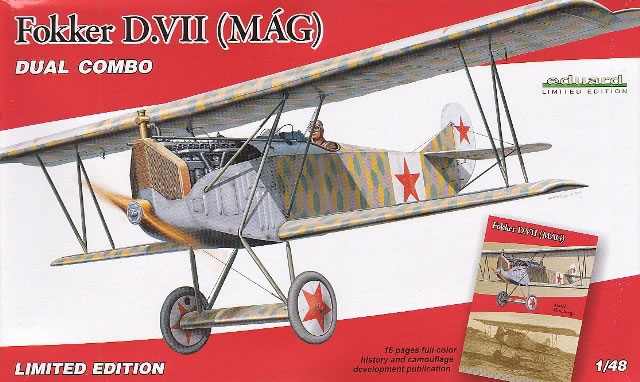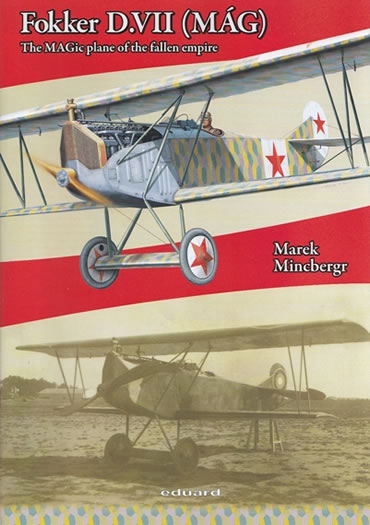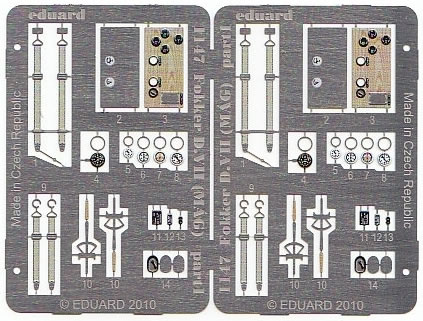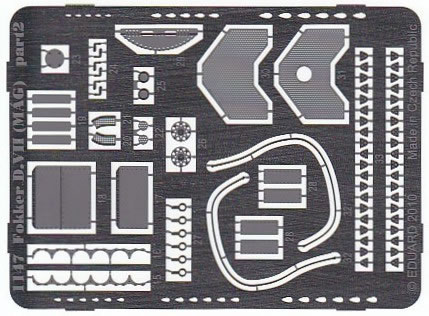Fokker DVII (MÁG)
Dual Combo

Eduard, 1/48 scale
S
u m m a r y |
| Catalogue Number: |
Eduard Kit No. 1147 - Fokker DVII (MÁG) Dual Combo |
| Scale: |
1/48 |
| Contents and Media: |
122 olive coloured plastic parts; photo-etched parts; markings for eleven aircraft. |
| Price: |
USD$74.95 plus shipping available online from Eduard's website
and specialist hobby retailers worldwide |
| Review Type: |
FirstLook |
| Advantages: |
Inspired subject choice; two complete kits included; clean crisp mouldings; excellent fit with impressive attention to detail; intelligent use of photo-etched parts; handy masking set; decals in perfect register with minimal carrier film. |
| Disadvantages: |
|
| Recommendation: |
The popular “Dual Combo” series takes a look at the Fokker D.VII (MÁG) and reproduces the changes to the standard German fighter exceptionally well. With the majors differences replicated in plastic, and a new fret of photo-etched parts, this kit captures the essence of this much neglected variant. |
Reviewed by
Rob Baumgartner

Eduard's 1/48 scale Fokker D.VII MAG Dual Combo is available online from Squadron.com
It wasn’t just the German Air Service that wanted the Fokker D.VII.
The Austro-Hungarian Air Force also sought out this fighter. Fokker presented the V.22 prototype for their evaluation. It was delivered to Magyar Általános Gépgyár (MÁG), which was no surprise as Fokker had shares in this company. The LFT representatives liked what they saw.
Series production followed and by October 1918, six aircraft were built. They utilized the Austro-Daimler engines, associated radiators, and Schwarzlose machine guns. The war ended before the LFT could take delivery of these aircraft and as a consequence were transferred to the Hungarian Air Force.
The post-war Fokker flew in a variety of guises and configurations. As such, it makes an ideal choice for those wishing to model a subject that’s a little bit different from the norm.
Contents
The “Dual Combo” format has been chosen to introduce this aircraft to the modelling community.
The release allows the purchaser to build two complete kits and also includes an excellent booklet by Marek Mincbergr. This publication explains the history, colours, and markings seen on this often neglected variant.

Naturally, this version shares some of the sprues seen in previous Eduard Fokker D.VII releases. Fortunately these have not suffered along the way and combine to provide a total of 122 plastic parts per aircraft. To allow for an even greater level of detail, there are three frets of photo-etched items. Once again there are enough to cover both aircraft and these have been specifically designed for the MÁG series.
What makes this machine different is the Austro-Daimler engine. It’s contained on the new “X” sprue and composes of over 20 parts including some great p-e enhancements.


Sprue “G” is also new and supplies the required choice of radiators, exhaust, and propellers. A different set of fuselage halves are found here with one of these having a separate top cowling. This is to expose the engine as seen on many examples in the field.
The Schwarzlose machine guns are catered for as well, and of course this means we get the new ammo cans to go with them. Some will be surprised to see a couple of Vickers guns on this tree. They are intended for option “E” and these “foreign” weapons will certainly surprise the uninitiated. And yes...the appropriate ammunition boxes are included for them.
The rest of the cockpit follows standard D.VII practice. Here one finds a partial representation of the inner structure which is moulded to the inner fuselage halves. Plastic additions come in the form of a floor, rudder bar, control column, pressure pump, seat and rear “fabric” screen. “Lozenge” decals are added to the latter item as well as the interior cockpit sides. Supplementing the assembly are photo-etched items which take care of the selector switches, foot plates, and magneto. The always welcome coloured items in this material cater for the seatbelts, instrument panel, dial faces and “throttle” lever.
Each wing is of single span and comes with separate upper and lower halves. The trailing edges are commendably thin and all rib locations are represented by moulded on “tapes”. If you wish to animate your aircraft, this can be easily done thanks to the separate ailerons, elevators and rudder.
In common with the rest of Eduard’s D.VII series, the assembly process is fairly straight forward.
To give your subject a bit more finesse, the remainder of the p-e provides detail for the radiator grill, deck covering, thrust plate, strut brackets, axle wing, machine guns…and more.
The clever way of eliminating the lower fuselage seam remains, this being accomplished by incorporating a plastic strip to replicate the undersurface stitching. It fits perfectly and looks great under either a coat of paint, or “lozenge” decal.
Markings
There’s a generous selection of 11 subjects available on the decal sheet. Many of the schemes are of the same machine but show it at various stages of its life.

That makes them no less interesting as there are significant differences in either colours or fittings.
-
Fokker D.VII (MÁG) 8. Vörös Repülöszázad, Hungarian Red Army, 1919
-
Fokker D.VII (MÁG) “Black” 93.07, Hungarian Red Army, 1919
-
Fokker D.VII (MÁG)W.Nr. 3867, Czechoslovak Air Force, summer 1919
-
Fokker D.VII (MÁG) W.Nr. 3867, Czechoslovak Air Force, autumn 1919
-
Fokker D.VII (MÁG) W.Nr. 3867, Czechoslovak Air Force, 1920
-
Fokker D.VII (MÁG) “White 16”, W.Nr. 3867, Czechoslovak Air Force, First Air Meeting, September 1921
-
Fokker D.VII (MÁG) W.Nr. 3867, Czechoslovak Air Force, summer 1922
-
Fokker D.VII (MÁG) W.Nr. 3867, Czechoslovak Air Force, summer 1923
-
Fokker D.VII (MÁG) W.Nr. 3867, Czechoslovak Air Force, late summer 1923
-
Fokker D.VII (MÁG) “White” 93.18 of Romanian Air Force 1919 or 1920
-
Fokker D.VII (MÁG) “White” 93.16 of Romanian Air Force flown by Lt. Bontescu
The supplied decals are very comprehensive and are contained on six sheets of various sizes. “Lozenge” is a very necessary part of these aircraft and Eduard has supplied their non-weathered variety. Specifically for the MÁG release, we also get lozenge for the rib tapes, rudder, fin, and wheel covers.
There is even a portion designed to fit the axle wing which will raise a few eyebrows!
Despite the large number of colours used, the sheet containing the personal and national markings was in perfect register. This was the norm with the lozenge as well.
Who would have thought that a major manufacturer would release a kit of the Fokker D.VII (MÁG)?
Thankfully Eduard has chosen to replicate this variant and have provided a new fuselage as well as the expected engine, radiator, airscrews and armament. The detail is up to the usual high standard and the type is significantly different to warrant inclusion in any enthusiast’s collection.
It’s certainly an inspired choice of subject and one that deserves to do well.
Thanks to Eduard for the sample
Review Text and Images Copyright © 2010 by Rob Baumgartner
Page Created 20 May, 2010
Last updated
20 May, 2010
Back to HyperScale Main Page
Back to Reviews Page

|
